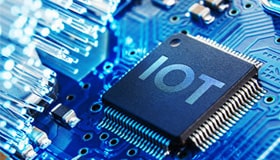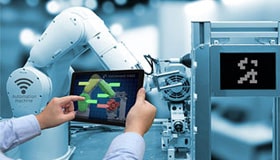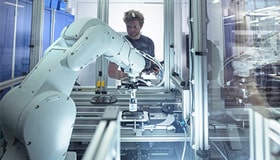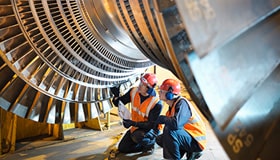Top 10 sensors used in smart manufacturing
Introduction
Sensors are essential to smart manufacturing. A smart sensor collects data on the physical environment and transmits it to centralised cloud computing platforms. This collected data is then processed and analysed. They allow seamless connectivity inside any automated manufacturing plant. Sensors in Industry 4.0 detect many transitions, such as changes in position, displacement, temperature, and pressure in industrial production.
The manufacturing process uses different sensors, each with a purpose. The smart sensor integrates signal conditioning, firmware, and MEMS technology, to meet the low-cost perception and easy-to-use needs of industrial design engineers and significantly reduce the development burden of design engineers. This article will discuss the top 10 sensors commonly used in the smart manufacturing industry.

Figure 1: Sensor Segment will grow at the highest CAGR of 11.8% during 2020 – 2027
The worldwide industrial sensors market is expected to develop at a CAGR of 11.8%. (Cited) during the 2020 to 2027 period. Industry 4.0 enhances production and industrial automation across several industry verticals.
A specific sensor serves a particular industrial application. The list of the ten most commonly used Industrial sensors includes:
Temperature sensors

In industrial production, a temperature sensor collects information about temperature from the surrounding environment and converts it into specific values. Digital temperature sensors contain digital temperature sensor sampling cards and are ubiquitous in industrial automation. A typical sampling card may have a 10-digit dual-channel successive approximation analogue to a digital converter and a standard RS-232 or 485 communication interface. The product uses a filtering method combining recursive hardware circuit filtering and average digital software filtering to minimise external interference to sampling, with good consistency, high full-scale accuracy, strong stability, and fast response.
A few digital temperature sensors can measure relative humidity and temperature. You can use such probes as temperature measurement components to collect humidity and temperature signals. These signals, after circuit processing, are converted into voltage or current signals that have a linear relationship with the humidity and temperature. These signals directly pass through to the main control chip and use an RS232 or RS485 interface output.

Pressure sensors

Pressure sensors capture pressure changes and transform them into electrical signals, where the applied pressure defines its quantity. These electro-mechanical devices identify force in liquids or gases and provide display devices with control signals. Pressure sensors can also detect atmospheric changes. For example, barometric pressure sensors can detect changes in the atmosphere and help to predict weather patterns and changes.
Unlike traditional installations, smart pressure transmitters use a sensor to convert pressure into an electric signal, which is amplified and passed to the built-in converter. The converter constantly updates and processes this data to create measurements and active regulation. Smart pressure transmitters generate analogue electrical and digital signals that they can send through HART, Modbus, Fieldbus, and other protocols. The microprocessor on the transmitter's board enhances its accuracy and expands its list of functions. Find out more about pressure sensors.
Infrared sensors
An infrared sensor uses infrared wavelength signals to create and process data without direct contact to the target object during measurement. The benefit of no physical contact means that there is no friction between the target and the sensor. This sensor is extremely sensitive, has a fast response time, and is used in non-contact temperature measurement, gas composition analysis, and non-destructive testing.

Proximity sensors

The Inductive proximity sensor can perceive the presence of an object. It uses techniques such as the change in an induced magnetic field to recognize the proximity of the target object and outputs the corresponding switch signal. This sensor can detect nearby metal objects without contact. This non-contact sensing does not damage or wear the detected object, giving it a long service life. The proximity sensor differs from other detection methods in that it can be utilised in a water and oil environment and is not affected by any contamination, water, and oil on the detection object.
Force sensors
Force sensors translate applied forces (such as tensile, compressive force, etc.) into electric signals, reflecting the degree of force. These signals are then sent to computers, indicators, or controllers that give the data needed to achieve control over machinery and processes. Smart factories use a variety of force sensors depending upon the type of force to be measured. For instance, load cells measure compressive forces, strain gauges measure the internal resistance forces, and force-sensing resistors measure the rate of change of an applied force.

Flow sensors

These sensors can sense the movement of solids, gases, or liquids flowing through a pipe or a conduit. Flow sensors are extensively used in processing industries and allow optimal performance of machines. A flow sensor can be electronic, using ultrasonic flow sensing, or partially mechanical. Electromagnetic flowmeters find primary use in water management, life sciences, and food industries.
Smoke sensors
A smoke sensor senses smoke (airborne particulates and gases). This sensor is essential in a flammable and explosive industrial manufacturing environment. The smoke sensor sounds the alarm signal when it detects a large amount of fire-originated smoke. The MCU control embedded inside a smoke sensor helps to detect smoke at an early stage. It gives a smart alert through a buzzer connected to the device. When industrial IoT solutions integrate smoke sensors, major disasters can be averted, with even a tiny gas leak or minor fire reported to the relevant team

Optical sensors

The optical principles such as visible or Infrared light form the basis of the optical sensor, with non-contact and non-destructive measurement, almost no interference, high-speed transmission, and remote control being its many advantages. General optical measuring instruments, laser interferometers, gratings, encoders, and fibre optics use optical sensors. The design of an optical sensor allows it to detect the proximity of a target object and perform various stages in industrial automation.
Motion and position sensors
Motion and position sensors detect objects that are either moving or can change their position. Motion and position sensors sense the positions of valves, doors, throttles etc. These sensors have location tracking abilities that help to determine the precise positions of machine tools, and other production-relevant items within the facility.
Motion sensors such as PIR (Passive Infra Red) sensors can alert a user of any motion within a particular target area and can trigger actions such as illuminating a floodlight by detecting object movement.
Position sensors detect the movement of a chosen object in either a rotary or linear motion. They convert such movement into signals suitable for processing, transmission or control.
Image sensors
An image sensor converts the optical image into an electrical signal. These sensors are used in both analog and digital type electronic imaging devices like computer vision, imaging tools used for medical, camera modules, night vision tools like radar, thermal imaging devices, sonar, digital cameras etc.
Image sensors are of two types: CCD (charge-coupled device) and CMOS (complementary metal-oxide-semiconductor). CCD image sensors use a charge-coupling mechanism to transfer the electrical charge from each pixel to a readout circuit. They are known for their high image quality and low noise. Conversely, CMOS image sensors use a metal-oxide-semiconductor process to create the pixels and readout circuits on a single chip. They are more cost-effective and energy-efficient than CCD sensors but have marginally lower image quality and higher noise levels.
Image sensors play an important role in smart manufacturing by providing visual data for monitoring and inspecting products and equipment. They can detect and analyze defects, track the movement of equipment and products, and monitor the overall quality of products. In addition, image sensors can be integrated with other technologies, such as machine learning (ML) and artificial intelligence (AI), to analyze and extract information from images. This can help improve automation and decision-making in manufacturing operations.






